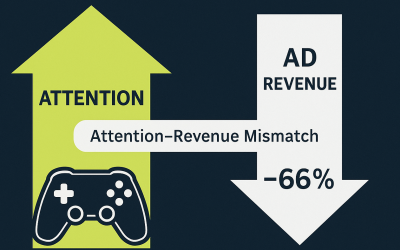The Hidden Costs of Implementing Reward Video Ads
Reward video ads have become a popular monetization strategy in the mobile and online gaming industry. These ads offer players in-game rewards in exchange for watching video content, which can boost engagement and generate revenue. However, just like with any effective tool, there are hidden costs and challenges associated with reward video ads that developers should consider.
While reward video ads bring clear benefits, it’s essential to weigh these against potential downsides to determine if they are right for your game. Let’s examine some of the hidden costs and common challenges that come with implementing reward video ads.
Contents
- 1 1. Inability to Maintain Stable Virtual Currency Value
- 2 2. General Dislike for Ads Among Users
- 3 3. Integration and Security Challenges
- 4 4. Impact on Game Flow and Player Experience
- 5 5. Potential Effects on Player Retention and Loyalty
- 6 Final Thoughts: Weighing the Costs and Benefits of Reward Video Ads
1. Inability to Maintain Stable Virtual Currency Value
One of the most significant challenges with reward video ads is the fluctuation in eCPM (effective cost per thousand impressions) rates. Reward video ads do not pay the same eCPM across regions or time. This inconsistency can make it difficult for developers to assign stable value to their in-game currency.
The Impact of Geographic Variation on eCPM
- In the U.S., eCPM rates for video ads can reach around $10, while in regions like Indonesia, eCPMs may average around $2.
- This discrepancy means that players in low-eCPM regions receive the same virtual rewards as those in high-eCPM regions but at a fraction of the revenue value.
- Over time, these fluctuations can lead to an imbalance in the in-game economy, as players in some regions are able to earn virtual currency much more affordably than others.
Strategies for Managing Virtual Currency Value To manage currency stability, developers can adjust in-game item prices based on region or create tiered reward systems. This approach can help keep the in-game economy balanced and prevent devaluation of in-game assets due to regional ad revenue variations.
2. General Dislike for Ads Among Users
Most users would prefer an ad-free experience, even in free-to-play games. While reward video ads tend to be more user-friendly than other types of ads, some players still find them intrusive. Introducing ads as part of the game’s monetization strategy may result in some user loss, as players seeking a completely ad-free experience may abandon the game.
Balancing User Retention and Ad Revenue
- Studies suggest that most players are open to watching ads if they receive valuable rewards. However, there will always be a segment of users who dislike ads, no matter how well they are implemented.
- Developers need to weigh the potential revenue from reward video ads against the likelihood of losing a small percentage of users. If ad engagement rates remain high and retention is above 90%, the revenue generated from ads may still make them worthwhile.
- Offering players the option to remove ads via an in-app purchase can help retain users who are averse to ads. This option provides a compromise, allowing players who value an ad-free experience to pay for it while monetizing the remaining user base.
3. Integration and Security Challenges
Integrating video ads is not as straightforward as placing banner ads. Reward video ads require more complex integration, particularly if server-to-server communication is involved. Developers need to evaluate the time and resources required to implement these ads effectively, especially if they are integrating multiple ad networks.
Technical Complexity of Video Ad Integration
- Video ads often involve more intricate setup processes, requiring developers to work with SDKs (Software Development Kits) from ad networks. Unlike banner ads, video ads need to load and play seamlessly, which can require adjustments to the game’s code.
- Additionally, reward video ads can be more susceptible to ad fraud, including practices like bot traffic and ad stacking. Developers should invest in secure, server-to-server integration to protect against fraudulent activities and ensure accurate ad performance tracking.
Considerations for Choosing Ad Networks When choosing an ad network, consider how complex the integration process is and the level of security provided. Some networks, like AppLixir, prioritize server-to-server integrations to reduce fraud risks, making them a more secure option for developers looking to implement reward video ads.
4. Impact on Game Flow and Player Experience
Reward video ads offer clear incentives for players, but poorly placed ads can disrupt the gaming experience. When ads interrupt critical gameplay moments, they can frustrate players and detract from their enjoyment of the game.
Best Practices for Ad Placement To maintain a positive experience, place ads at natural breaks, such as after completing a level or before starting a new challenge. Avoid placing ads during high-action moments, as this can disrupt player flow and reduce engagement. Strategic ad placement is essential to balance monetization with user experience.
Testing Ad Placement for Optimal Results Continuously test different ad placements to see which options yield the best results in terms of both engagement and revenue. By analyzing player behavior and ad performance, developers can refine their ad placement strategy to enhance the gaming experience and maximize monetization.
5. Potential Effects on Player Retention and Loyalty
While reward video ads can enhance player engagement in the short term, overuse or poorly implemented ads can impact player loyalty. Players may become fatigued by frequent ad interruptions, potentially reducing retention rates over time.
Using Data to Guide Frequency and Placement
- Monitor metrics like session length, ad engagement rates, and retention to identify the right frequency for reward ads. Limiting ad exposure based on data insights can help maintain engagement without overwhelming players.
- Additionally, offering high-value rewards for watching ads sparingly (rather than frequently) may help increase ad engagement without causing burnout.
In-App Purchases as a Backup Option For players who dislike ads, offer in-app purchases as an alternative monetization strategy. Allowing players to purchase items directly instead of watching ads provides them with a choice, helping retain users who might otherwise leave due to ad fatigue.
Final Thoughts: Weighing the Costs and Benefits of Reward Video Ads
Reward video ads are an effective monetization tool for many games, but they come with hidden costs that developers should consider carefully. From maintaining currency stability to balancing user retention and dealing with technical challenges, each of these hidden costs requires strategic planning and testing. However, with the right approach, the benefits of reward video ads can outweigh the costs, providing a sustainable revenue stream without significantly disrupting the player experience.
The decision to implement reward video ads ultimately depends on the game’s audience, monetization goals, and gameplay flow. By weighing the costs and applying best practices, developers can successfully integrate reward video ads and enjoy their revenue-generating potential.
About AppLixir:
AppLixir provides a robust reward video ad platform tailored for Facebook, WebGL, and mobile apps, helping developers maximize revenue while enhancing player engagement. With a focus on secure integration and easy implementation, AppLixir is a trusted partner for game monetization.



